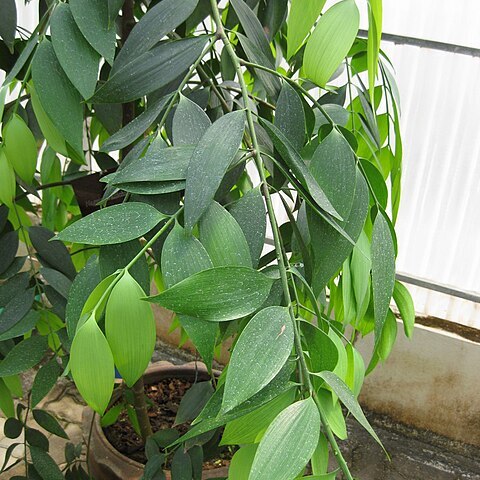Trees to 50 m tall; trunk to at least 1 m d.b.h.; bark smooth, dark brown or gray-brown, tan or brown within, peeling in large, irregular flakes. Leaves decussate, 2-ranked, turned so that those on 1 side of branch have adaxial surface uppermost, those on the other side abaxial surface uppermost; petiole 5-10 mm; blade dark green adaxially, paler or grayish green abaxially, elliptic or lanceolate-elliptic, (6-)9-14 × (2-)3-5 cm in adult leaves, or to 23 × 7 cm in juvenile leaves, thick and leathery, stomatal lines present on both surfaces, base cuneate to attenuate, apex acuminate. Bracts of pollen-and seed-cone peduncles deciduous. Pollen cones axillary, in clusters of (1-)3-5 (-7) on peduncle 0.2-1 cm, 1 cone terminal, others decussate, cylindric, 0.8-1.8 cm × 4-5 mm; microsporophylls lanceolate, 2-3 mm. Seed-bearing structures axillary, solitary or rarely paired; peduncle (0.5-)1.2-1.7(-2) cm. Receptacle of 4-7 sterile scales and 1 or 2 fertile, subterminal scales, green initially, blackish when ripe, very succulent. Epimatium bluish purple or purplish red when ripe. Seed globose, 1.5-1.8 cm in diam., with small, proximal beak.
More
Tree, 10-54 m high, 7-60 cm diam., clear bole to 30 m. Leaves quite variable both on juvenile and adult plants with the larger leaves growing in the shade, 6-14(-23) by 2-5(-9) cm, 2 to at least 6 times as long as broad; petiole 5-10 mm. Pollen cones in groups of up to at least 7 on a 2-10 mm peduncle; mature cone 8-18 by 3-4 mm. Apex of the microsporophyll lanceolate, 2-3 mm long. Seed-bearing structure solitary on a 8 to at least 20 mm peduncle with caducous scales or occasionally reduced leaves. Receptacle with 4-7 sterile, deflexed, slightly enlarged bracts, 7-18 mm long before becoming ripe and fleshy, dark purple or black when ripe. Seed with its covering 15-18 mm diam.
Scattered and often common in primary rain-forests, nowhere reported gregarious or dominant, from very low elevation (5 m) ascending occasionally as high as 2100 m.Collected in peat-swamps in Sumatra and Borneo, or dry parts of them, in the lowland, in Sarawak on basalt ridges and submontane kerangas, in E. Borneo (G. Beratus) in mossy forest on sandstone, in Sabah in sandy pelawan (Tristania) forest, in New Guinea on clay or sandy ridge forest, sometimes associated at submontane altitude with Anisoptera, Cinnamomum, Sloanea, Castanopsis, or with Araucaria-Podocarpus-Fagaceae at 700 m. In Thailand buttresses are recorded, at Arguni Bay (New Guinea) even high buttresses; this seems to occur occasionally.
More
A sub-canopy to canopy tree, scattered but often common in primary rainforest with canopy heights to 50 metres or more, occurring from lowlands to montane forested ridges at elevations to 2,100 metres.


